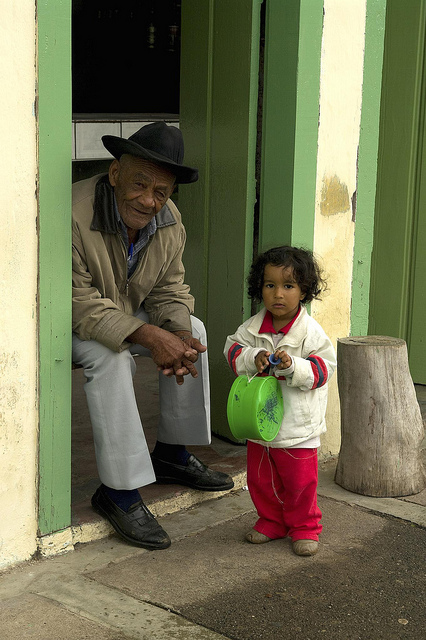[All links lead to Portuguese language pages except when otherwise noted]
Since the declaration of Brazil as an independent nation in 1822, Brazilian identity has gone through several changes spurred by economic, social and cultural transformations. In a country of several races [1] [en], classes, beliefs and traditions, with a great portion of its population descending from different continents [2] [en], and marked by drastic regional differences, is there a common Brazilian identity for every citizen? After all, what does it mean to be Brazilian?
Even though the Internet is a modern technology, its democratic and inclusive use can help in the search for an answer. Maybe such answer isn’t a direct reflection of the Brazilian identity; after all, less than 50 percent of the population [3] of around 200 million has access to the technology, and among these 50 percent, the predominance of certain groups can be observed. But the online world gathers several opinions and with a simple search, many can be found.
Several, in fact, have already tried to answer the question with their own words – or more importantly, through their own experience. But before we get to “Brazilian,” it’s worth explaining the concept of nation and nationality. According to journalist Mauro Santayana, in an article published on the website Contexto Livre [5] (Free Context):
A etimologia nos diz que pátria é o adjetivo para a terra de nossos pais. É a terra pátria, o que sugere a integração entre a realidade geográfica e a comunidade que nela vive, identificada pela língua, pela cultura e, mais do que por esses sinais, pelo sentimento de fraternidade (….) é, no fundo, a solidariedade cotidiana.
It’s also important to explain that identity in Brazil was constructed throughout the years. According to Eliene, in an article for the site Mundo Educação [6] (Education World):
A preocupação, de tentar construir uma identidade brasileira, começou no século XX, pois no século XIX, grande parte da população não era considerada oficialmente como brasileira. A partir de 1930, os órgãos governamentais começaram a introduzir elementos na nossa cultura, como por exemplo: o futebol, o carnaval, a feijoada, etc. Nesse período, na primeira metade do século XX, foi construída a imagem do brasileiro. Um povo cordial, bem-humorado, alegre e não racista. Porém, é válido ressaltar que os órgãos governamentais tentavam introduzir uma identidade, mas ela só foi aceita porque o povo se identificava com ela.
In a very simplistic way, the common link among every Brazilian is the simple sensation of feeling Brazilian. It seems obvious, but since the publication of Casa Grande e Senzala [7] [en] (Big House and Slave House), by Gilberto Freyre [8] [en] in 1933, and Raizes do Brasil [9] (Brazilian Roots), by Sergio Buarque de Holanda [10] [en] in 1936, much has been written [11] and theorized [12] about such definition. And what about the online community? What does it think?
History Professor Lázaro Curvelo Chaves, categorically opens his definition [13]:
Somos um povo sui generis em vários aspectos. Alguns ditados populares têm lá a sua razão de ser. Aqui há “leis que pegam” e “leis que não pegam”, depende de a quem se aplica. A rigidez da letra fria da lei esbarra no “jeitinho brasileiro”, no “favor”, no quebra-galho.
But what about the notion of soccer, religion and carnival? Yes, some still define Brazilian in terms of the national soccer team [14], others through music [15], but as Diogo Didler writes in his website “Ser Feliz e ser Livre [16]” (To Be Happy is To Be Free):
Ser brasileiro vai muito além do que torcer por um time, ser sambista, ter uma religião ou gostar de mulher. É, antes de tudo, um exercício de cidadania do qual cada um enxerga a nossa realidade e tentar de alguma forma mudá-la qualitativamente em benéfico do povo. Ser brasileiro é, ainda, exaltar o que realmente temos de melhor e não coisas supérfluas que não trazem benefício algum para a coletividade social, mas sim pequenos paliativos que com o tempo serão esquecidos.
On Twitter [18], some people also express their impressions through the #brasileiro [19] (#Brazilian) hashtag.
Jose (@heyjholetsgo [20]) writes:
BOM DIA pro proletário que amanheceu encarangado mas segue na luta #sou #brasileiro #nao #desisto
Also, Tiago G. Estevam (@tiagogestevam [21]) agrees that:
#Brasileiro é uma MultiMistura genética formidável! Por isso temos tanta pessoas talentosas, potencializamos as qualidades das decendencias.
If such identity refers to the national territory, what about Brazilians living beyond national borders? Does this “Brazilianity” cross territories? While some say [22] it’s easy to recognize Brazilians living abroad through stereotypes, Debora Baldelli [23], co-editor at Global Voices in Portuguese, recognizes in her blog Urbanices [24], that abroad, from a physical standpoint, “the idea that ‘Brazilians do not have a face (or has all the faces of the world)’ isn’t a worldwide perception as I thought it was.” Yes, Brazilians have a face and an identity, and even though everybody is unique, we are also Brazilians, independently from the localization.
Among so many opinions, is there also Brazilian pride online?
With the question “Are you proud to be Brazilian? [25],” Jessica launched the challenge on the Yahoo! [26]. The answers are mixed, varying from those who love the country for its natural resources to those who are not so passionate. The vlogger Catharina Lopes also tried to express her feelings in the video community Youtube [27].
http://www.youtube.com/watch?v=38O15Roa6Dg [28]
But can an online forum and some videos really reflect the opinion found in the offline world? According to data published on the website To Be Guarany [3], “there are 79,9 million Brazilian Internet users, being the fifth largest country connected to the Internet, and with an intense growing rate.” But social inequality is also present online. According to a research [29] done by the Brazilian Senate in 2011:
Entre os 10% mais pobres, apenas 0,6% tem acesso à Internet; entre os 10% mais ricos esse número é de 56,3%. Somente 13,3% dos negros usam a Internet, mais de duas vezes menos que os de raça branca (28,3%). Os índices de acesso à Internet das Regiões Sul (25,6%) e Sudeste (26,6%) contrastam com os das Regiões Norte (12%) e Nordeste (11,9%).
Although numbers have changed a bit during this period, we are still far from reaching online equality. But if it indeed exists a single Brazilian identity, it’s precisely this – the diversification of opinions, realities and experiences united over a common land.

